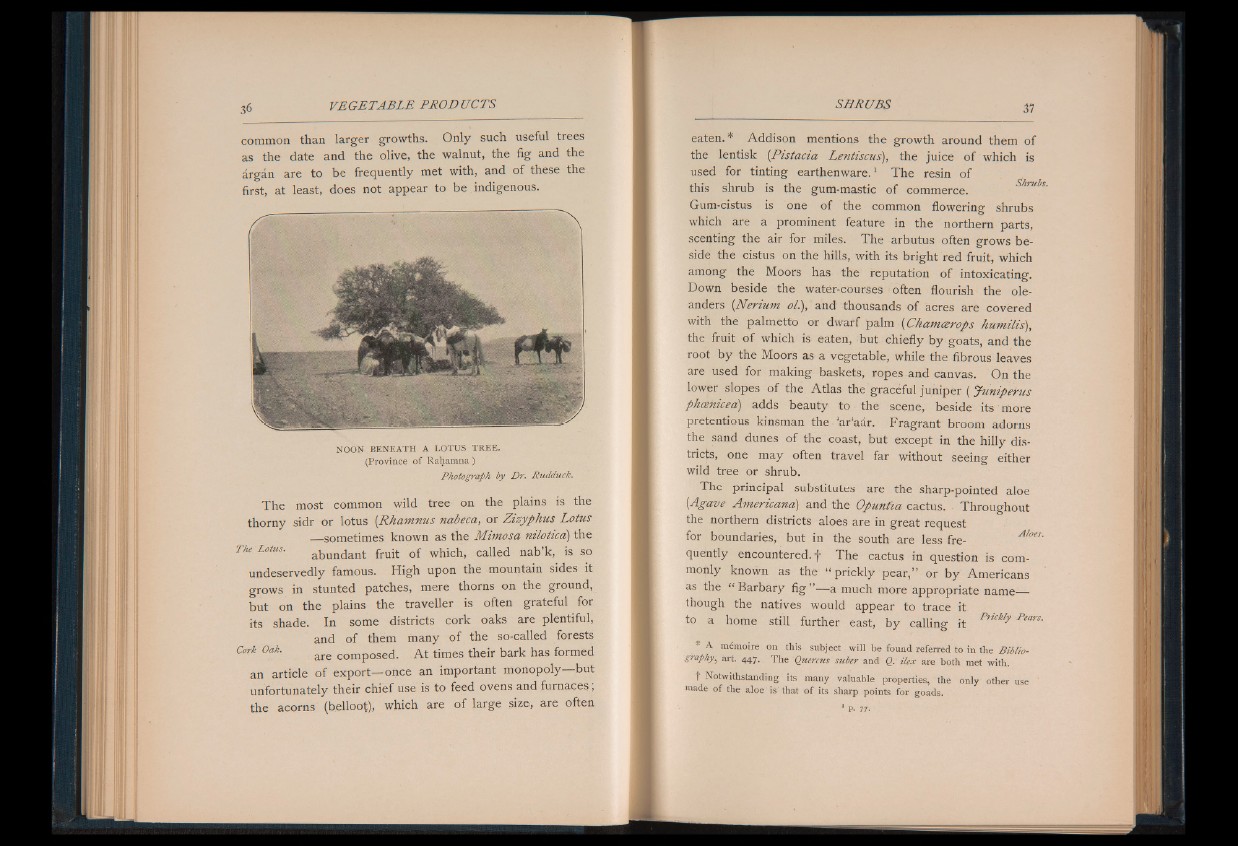
common than larger growths. Only such useful trees
as the date and the olive, the walnut, the fig and the
argan are to be frequently met with, and of these the
first, at least, does not appear to be indigenous.
NOON BENEA TH A LO TUS TR E E .
(Province of Rahamna)
Photograph by Dr. Rudduck.
The most common wild tree on the plains is the
thorny sidr or lotus (Rhamnus nabeca, or Zizyphus Lotus
sometimes known as the Mimosa nilotica) the
The Lotus. abUndant fruit of which, called nab’k, is so
undeservedly famous. High upon the mountain sides it
grows in stunted patches, mere thorns on the ground,
but on the plains the traveller is often grateful for
its shade. In some districts cork oaks are plentiful,
and of them many o f the so-called forests
Cork Oak. jg g composecj A t times their bark has formed
an article of export— once an important monopoly— but
unfortunately their chief use is to feed ovens and furnaces;
the acorns (belloot), which are of large size, are often
eaten.* Addison mentions the growth around them of
the lentisk (Pistacia Lentiscus), the juice of which is
used for tinting earthenware.1 The resin of
this shrub is the gum-mastic of commerce.
Gum-cistus is one of the common flowering shrubs
which are a prominent feature in the northern parts,
scenting the air for miles. The arbutus often grows beside
the cistus on the hills, with its bright red fruit, which
among the Moors has the reputation of intoxicating.
Down beside the water-courses often flourish the oleanders
(Nerium ol.), and thousands of acres are covered
with the palmetto or dwarf palm ( Chamatrops kumilis),
the fruit of which is eaten, but chiefly by goats, and the
root by the Moors as a vegetable, while the fibrous leaves
are used for making baskets, ropes and canvas. On the
lower slopes of the Atlas the graceful juniper ( Juniperus
phoenicea) adds beauty to the scene, beside its more
pretentious kinsman the ’ar’aar. Fragrant broom adorns
the sand dunes of the coast, but except in the hilly districts,
one may often travel far without seeing either
wild tree or shrub.
The principal substitutes are the sharp-pointed aloe
(.Agave Americana) and the Opuntia cactus. Throughout
the northern districts aloes are in great request
for boundaries, but in the south are less fre- Aloes'
quently encountered, f The cactus in question is com-
moply known as the “ prickly pear,” or by Americans
as the “ Barbary f ig ”— a much more appropriate name—
though the natives would appear to trace it
to a home still further east, by calling it P' uUy Pears'
A mémoire on this subject will be found referred to in the Bibliography,
art. 447. The Quercus suber and Q. ilex are both met with.
t Notwithstanding its many valuable properties, the only other use
made of the aloe is that Of its sharp points for goads.
1 P. 77.